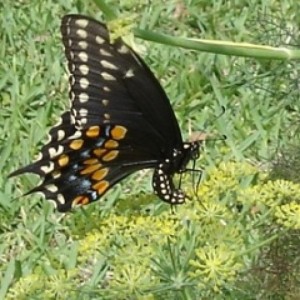
We hear a lot of talk now about the importance of pollinators. There have been numerous articles encouraging us to plant for pollinators in our garden and landscapes. And, what a good idea that is! Bees, butterflies, even flies can all serve to pollinate our plants.
Many of our food crops need pollinators to form the fruits and vegetables we eat daily. Some vegetables are wind pollinated, but most are pollinated by insects. Have you ever grown squash or cucumbers, seen lots of flowers on your plants but had few or no vegetables form? The main reason for that is lack of pollination. Those crops, the circubits, have both male and female flowers. The pollen needs to be transferred from the male flower to the female one for the fruit to form. That’s where the bees come in. While they are after the pollen for their hives, as a side benefit, they transfer pollen from flower to flower creating the magic that makes our squash and cucumbers form. There would be no Hallowe’en Jack O’ Lanterns without the bees!
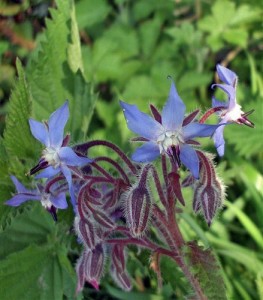
Pollinators also help the plants set good, viable seed. By cross pollinating within a species, strong seed is created to carry on the best traits of the current generation.
Sometimes, though, the pollinators create unwanted crosses in the garden. If you’re growing several types of squash, for instance, and want to save the seed, having the plants too close together can cause cross pollination and the resulting seed is not the variety you thought it was. Sometimes these hybrids turn out OK, but most often they are not very tasty.
I usually grow several types of basil in the garden. I have had volunteer seedlings come up that look like sweet basil but have a distinctive lemon flavor due to the bees bringing the pollen from the lemon basil to the sweet basil.
Peppers are notorious crossers. If you save seeds from sweet bell peppers that have been grown close to hot peppers, you might have hot bell peppers from the seed you plant next season!
Pollinators for every garden
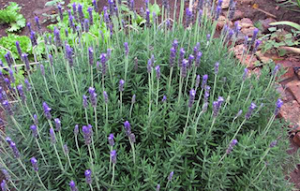
Here is a list of plants that attract various pollinators. As you can see, many do double or triple duty!
Herbs That Attract Butterflies
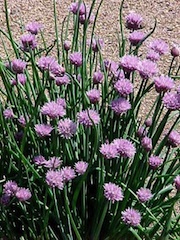
Butterflies like lots of sun and low wind areas. If you live in a windy area, try planting a windbreak or planting your butterfly attractors in a sheltered area.
Remember, the larva of the butterflies will eat the leaves of your host plants such as parsley, rue and dill. That’s why the butterfly lays her eggs on those plants. So, if you want butterflies, you have to let the larva eat the leaves.
- Parsley
- Dill
- Rue
- Chives
- Thyme
- Catmint
- Marjoram
- Mint
- Yarrow
- Mexican Oregano (Poliomintha longiflora)
Herb Flowers That Attract Bees
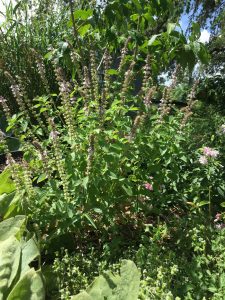
In some cases, like with basil, you will sacrifice some harvesting to let the flowers grow on the plant. So, plant lots, harvest some and leave the rest for the bees!
- Basil, especially African Blue Basil
- Lemon balm
- Marjoram
- Chamomile
- Thyme
- Lavender
- Anise hyssop
- Hyssop
- Yarrow
- Savory
- Borage
- Germander
- Sage
- Rosemary
- Dill
- Betony
- Dandelion
Herb Flowers That Attract Hummingbirds
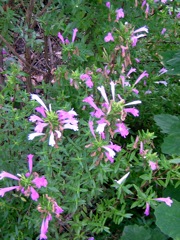
Don’t forget the hummingbirds! They’re pollinators, too.
- Pineapple sage
- Mexican Oregano (Poliomintha longiflora)
- Bee balm
- Lavender
- Hyssop
- Catnip
Be sure to have water sources for your pollinators. Shallow bowls work best. Place them in your beds for easy access for our hard working friends.
Here’s a link to Part 1 an article on attracting pollinators here in Texas- Houston, specifically. It’s from the Lazy Gardener and Friends, Houston Garden Newsletter.
I hope you give lots of room in your gardens to plant for the pollinators. Of course, it’s not just herbs that attract them. Lots of flowers and flowering shrubs and even trees will bring the pollinators to your yard.
QUOTE FOR THE MONTH

We all should know that diversity makes for a rich tapestry, and we must understand that all the threads of the tapestry are equal in value no matter what their color.
-Maya Angelou, poet (4 Apr 1928 – 28 May 2014)
